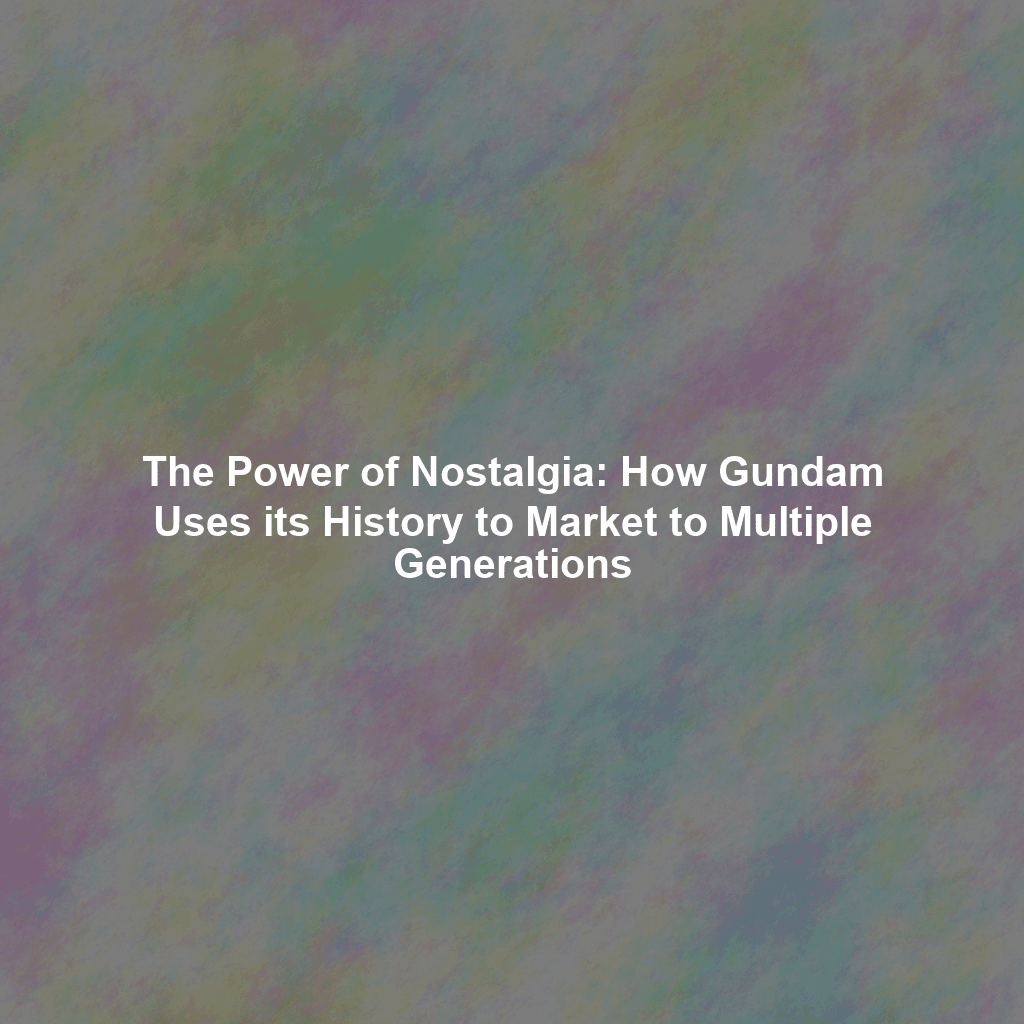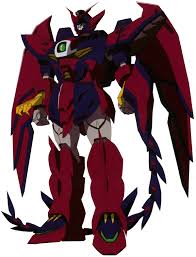Gundam by the Numbers (2024)
Total Franchise Revenue: Over $20 billion USD since 1979
Gunpla Sales: Over 700 million units sold worldwide
TV Series & Films: 50+ animated productions
Active Timeline Universes: 15 distinct storylines
Global Market Presence: 80+ countries
The Foundation: Understanding Gundam’s Nostalgic DNA
To comprehend Gundam’s nostalgic marketing prowess, one must first understand that nostalgia in Japanese media operates differently than in Western contexts. The concept of “natsukashii” (懐かしい) encompasses not just longing for the past, but a deep emotional connection to shared cultural experiences. Gundam taps into this by creating what media scholars call “manufactured nostalgia”—deliberately crafting content that feels both familiar and fresh, allowing multiple generations to share common emotional touchstones.
The franchise’s approach to nostalgia is multi-layered, operating simultaneously on several levels: visual iconography, narrative themes, character archetypes, and technological aesthetics. This comprehensive strategy ensures that nostalgic elements aren’t merely superficial callbacks but are woven into the very fabric of each new production.
The Psychology of Mecha Nostalgia
Research in consumer psychology shows that nostalgia marketing is particularly effective for products associated with childhood experiences and aspirational fantasy. Gundam occupies a unique position in this regard, as it combines the childlike wonder of giant robots with mature themes of war, politics, and human nature. This duality allows the franchise to age with its audience while continuously recruiting new fans.
Dr. Hiroshi Yamamoto, a consumer behavior specialist at Tokyo University, notes that “Gundam’s nostalgic appeal operates on what we call ‘telescopic nostalgia’—fans can appreciate both the immediate nostalgia of their own viewing experience and the inherited nostalgia of the franchise’s broader cultural impact, even if they weren’t present for the original broadcasts.”
The Enduring Appeal of the Universal Century
The Universal Century (UC) timeline, the setting of the original Mobile Suit Gundam and many of its most beloved sequels, serves as Gundam’s bedrock of nostalgia. Characters like Amuro Ray and Char Aznable are not just figures in a story; they are cultural icons for multiple generations of anime fans. What makes the UC timeline particularly powerful is its historical depth—spanning over 150 years of fictional history, it provides ample material for exploring different eras while maintaining narrative continuity.
The UC timeline’s success lies in its ability to function as both a nostalgic anchor and a springboard for innovation. Unlike many franchises that become trapped by their own continuity, Gundam uses the UC’s vast timeline to explore different historical periods, each with its own aesthetic and thematic focus, while maintaining the overarching narrative threads that longtime fans cherish.
Case Study: Mobile Suit Gundam Unicorn’s Nostalgic Strategy
Released between 2010-2014, Gundam Unicorn exemplifies masterful nostalgic marketing. The OVA series directly addressed unresolved plot threads from the original 1979 series while introducing cutting-edge animation techniques. Its success—generating over $200 million in revenue—demonstrated that nostalgic content could achieve both critical acclaim and commercial success when executed with reverence and innovation.
Remakes and Re-imaginings: A Nostalgic Gateway
Remakes, like the Mobile Suit Gundam: The Origin manga and anime adaptation, serve as a crucial entry point for new fans while satisfying longtime enthusiasts’ desire for enhanced versions of beloved stories. By retelling the classic UC story with updated animation and deeper character development, Gundam re-introduces its foundational narrative to a modern audience. This isn’t simply a rehash; it’s a carefully crafted re-imagining that respects the original while offering a fresh perspective.
The Origin’s approach demonstrates what industry analysts call “respectful enhancement”—improving technical aspects like animation quality and sound design while preserving the core emotional beats that made the original compelling. This strategy avoids alienating hardcore fans while simultaneously making the complex UC timeline more accessible to newcomers who might be intimidated by the franchise’s extensive history.
Market research conducted by Bandai Namco revealed that 60% of Origin viewers were experiencing UC Gundam for the first time, while 85% of longtime fans rated it as a worthy addition to the timeline. This dual appeal is the hallmark of successful nostalgic marketing—expanding the audience without diminishing the core experience.
Sequels: Continuing the Legacy
Sequels within the UC timeline, such as Mobile Suit Gundam Narrative, Gundam F91, and the recent Mobile Suit Gundam: Hathaway’s Flash trilogy, continue the UC timeline while building upon established lore and characters. These sequels serve as a direct appeal to long-time fans who are invested in the fate of the UC universe. By resolving lingering plot threads and introducing new mobile suits within a familiar context, Gundam ensures that its dedicated audience remains engaged and invested in the franchise’s future.
The strategic timing of these sequels is particularly noteworthy. Rather than rushing to capitalize on nostalgia, Gundam often allows decades to pass between related productions, creating genuine anticipation and allowing new generations to discover the source material. The 12-year gap between Char’s Counterattack (1988) and the announcement of Unicorn (2010) created a perfect storm of pent-up demand and nostalgic longing.
UC Timeline Strategic Releases
1979-1980: Original Mobile Suit Gundam establishes foundation
1985-1988: Zeta and ZZ Gundam expand immediate aftermath
1988: Char’s Counterattack provides climactic conclusion
2010-2014: Unicorn revisits and resolves lingering questions
2021-2024: Hathaway trilogy explores next generation
Beyond the Universal Century: Spreading the Nostalgia
While the UC holds a special place in Gundam’s history, the franchise has expanded into numerous alternate universes (AUs), each designed to attract different demographics while maintaining the core Gundam identity. Even within these AUs, Gundam strategically employs nostalgic elements to create a sense of familiarity and connection, proving that nostalgia can transcend specific continuities when properly implemented.
The AU strategy serves multiple purposes: it allows creative teams to explore new themes without being constrained by UC continuity, it provides entry points for fans who might find the UC timeline overwhelming, and it creates opportunities to experiment with different nostalgic approaches. Series like Mobile Fighter G Gundam leverage nostalgia for martial arts films, while Gundam SEED deliberately echoes the original series’ structure to create what fans call “nostalgic resonance.”
Referential Humor and Homage
Many Gundam series, even those set in new timelines, include subtle nods and references to the UC and other previous series. This can range from visual homages to iconic mobile suits to thematic parallels with classic UC storylines. These references reward long-time fans for their knowledge and understanding of the franchise’s history, creating a sense of shared experience and insider knowledge that strengthens community bonds.
The referential approach operates on multiple levels of accessibility. Casual viewers can enjoy the surface story, while dedicated fans can appreciate deeper connections and easter eggs. This layered approach to nostalgic content ensures that productions can satisfy both new audiences and longtime enthusiasts without compromising either experience.
For example, Gundam Build Fighters transforms nostalgic references into the series’ primary appeal, featuring Gunpla models from across the franchise’s history. Rather than being mere fanservice, these references become integral to the show’s themes about passion, craftsmanship, and the joy of creation—values that resonate with the franchise’s core philosophy.
Reusing Popular Themes and Character Archetypes
Gundam consistently re-imagines popular themes like the “rival pilot” (often inspired by Char Aznable) or the “reluctant hero” (similar to Amuro Ray) in new and exciting ways. These familiar archetypes provide a sense of comfort and familiarity for viewers, making it easier for them to connect with new characters and storylines. The “Char Clone” phenomenon has become so prevalent that it’s recognized as a distinct character type within anime fandom.
However, successful Gundam series don’t simply copy these archetypes—they evolve them. Mobile Suit Gundam: Iron-Blooded Orphans features McGillis Fareed, who initially appears to be a traditional Char-type character but ultimately subverts expectations by failing in his revolutionary goals. This approach satisfies nostalgic expectations while delivering narrative surprises that keep the franchise fresh.
The thematic consistency across different timelines creates what media theorists call “franchise DNA”—a set of recognizable elements that make any Gundam series identifiably Gundam, regardless of its specific setting or timeline. This DNA includes not just character types but also philosophical themes about war, the cost of conflict, the potential for human understanding, and the double-edged nature of technological progress.
The Gunpla Phenomenon: Nostalgia Made Tangible
No discussion of Gundam’s nostalgic marketing would be complete without examining Gunpla (Gundam plastic models), which represent perhaps the franchise’s most successful translation of nostalgic appeal into commercial success. Since 1980, Gunpla has generated over $2 billion in revenue, making it one of the most successful toy lines in history.
Gunpla succeeds as a nostalgic product because it allows fans to physically interact with their favorite mobile suits. The act of building, customizing, and displaying these models creates a tangible connection to the anime that extends far beyond passive viewership. Many adult collectors describe the meditative quality of Gunpla construction as a way to reconnect with the wonder they felt when first discovering Gundam.
Gunpla Market Impact
Annual Sales: Approximately $500 million globally
Model Variants: Over 3,000 different kits released
Adult Collectors: 70% of purchasers are over 18
International Growth: 300% increase in non-Japanese sales since 2010
Secondary Market: Rare kits can sell for 10x retail price
Limited Edition and Anniversary Releases
Bandai’s strategy of releasing limited edition and anniversary Gunpla kits demonstrates sophisticated understanding of nostalgic consumer behavior. These releases often feature enhanced detail, special packaging, and exclusive accessories that justify premium pricing while creating artificial scarcity that drives collector demand.
The “Real Grade” and “Perfect Grade” lines specifically target adult collectors who experienced Gundam in their youth and now have the disposable income to purchase high-end models. These products often feature engineering innovations that weren’t possible when the original anime aired, allowing fans to experience familiar mobile suits in entirely new ways.
Anniversary Campaigns: Celebrating the Legacy
Gundam anniversary campaigns represent the franchise’s most concentrated efforts to leverage nostalgia for commercial and cultural impact. These campaigns, occurring every five years for major milestones, demonstrate how nostalgia can be systematically deployed across multiple media channels to maximize both emotional resonance and market penetration.
The 40th anniversary campaign in 2019 exemplified this approach, generating over $300 million in revenue through coordinated releases across anime, games, merchandise, and events. The campaign’s success lay not just in its scope but in its ability to make longtime fans feel that their devotion was being acknowledged and celebrated.
Limited Edition Merchandise and Collectibles
Anniversary campaigns are frequently accompanied by the release of limited-edition merchandise that extends far beyond traditional Gunpla. These items include premium clothing lines, jewelry, home goods, and even automotive accessories. The diversity of products ensures that nostalgic appeal can be expressed across different lifestyle categories and price points.
High-end collectibles, such as Bandai’s “Chogokin” die-cast figure line or special edition watches, specifically target affluent adult fans who want to display their Gundam appreciation in sophisticated ways. These products often feature design elements that are subtle enough for professional environments while still being recognizable to fellow fans.
The collectibility factor is carefully managed through production limits and exclusive distribution channels. Many anniversary items are only available through specific retailers or events, creating a sense of exclusivity that enhances their nostalgic value. Resale markets for these items often see prices multiply by 300-500%, indicating the strength of collector demand.
Special Events and Exhibitions
Gundam anniversary campaigns often include large-scale events and exhibitions that provide immersive nostalgic experiences. The life-sized Gundam statues in Tokyo, Yokohama, and other cities represent the ultimate expression of this strategy—transforming fictional mobile suits into physical landmarks that fans can visit and experience in person.
These installations cost millions of dollars to construct and maintain, but their cultural impact extends far beyond their direct revenue generation. They serve as pilgrimage sites for international fans, generate significant media coverage, and create social media moments that spread Gundam awareness to new audiences. The Tokyo statue alone receives over 10 million visitors annually.
Smaller-scale events, such as traveling exhibitions featuring original animation cels, concept art, and historical artifacts, provide more intimate nostalgic experiences. These exhibitions often include interactive elements that allow fans to voice mobile suit dialogue or experience simplified versions of the piloting experience, creating new memories while celebrating old ones.
Cross-Promotional Collaborations
Collaborations with other brands during anniversary campaigns expose the Gundam brand to wider audiences while providing existing fans with unexpected ways to express their fandom. These partnerships range from fast-food promotions to luxury fashion collaborations, each tailored to specific demographic segments within the broader Gundam fanbase.
The collaboration with Japanese convenience store chain 7-Eleven in 2019 featured Gundam-themed packaging for everyday items like coffee and sandwiches, making the franchise visible to millions of consumers who might not actively follow anime. Meanwhile, partnerships with high-end fashion brands like Nike and Uniqlo create premium products that appeal to fashion-conscious fans who want to incorporate Gundam aesthetics into their personal style.
International collaborations have become increasingly important as Gundam expands globally. Partnerships with Western brands like Hot Wheels and McDonald’s help introduce the franchise to new markets while providing familiar cultural touchstones for international fans.
Digital Strategies: Nostalgia in the Internet Age
The digital era has fundamentally transformed how Gundam deploys nostalgic marketing, creating new opportunities for fan engagement while presenting challenges in managing such an extensive multimedia franchise. Social media platforms, streaming services, and mobile games have become crucial battlegrounds for nostalgic content, requiring sophisticated strategies to maintain relevance across multiple digital channels.
Streaming and Accessibility
The availability of classic Gundam series on streaming platforms like Crunchyroll and Funimation has democratized access to the franchise’s nostalgic content. Fans no longer need to rely on expensive DVD collections or unreliable fan uploads to experience the UC timeline chronologically. This accessibility has been crucial in attracting younger fans who might otherwise be intimidated by the franchise’s complexity.
Bandai’s strategic approach to streaming releases often creates “nostalgic events” by timing classic series availability with new product launches or anniversary celebrations. The simultaneous release of remastered versions alongside new productions creates natural comparison points that highlight both the franchise’s evolution and its consistent themes.
Mobile Gaming and Virtual Nostalgia
Mobile games like “Gundam Battle Operation” and “SD Gundam G Generation” serve as interactive nostalgia delivery systems, allowing players to collect and battle with mobile suits from across the franchise’s history. These games generate significant revenue—often exceeding $100 million annually—while serving as entry points for new fans and nostalgic experiences for veterans.
The gacha mechanics common in these games specifically exploit nostalgic desires by making rare mobile suits from beloved series available only through random draws. While controversial, this approach effectively monetizes nostalgia by creating artificial scarcity around digital representations of iconic mecha.
“The genius of Gundam’s digital strategy lies in its ability to make nostalgia feel interactive rather than passive. Players aren’t just remembering favorite mobile suits—they’re actively using them in new contexts, creating fresh memories built on nostalgic foundations.” – Dr. Sarah Kim, Digital Media Researcher
Global Expansion: Exporting Japanese Nostalgia
Gundam’s international success presents unique challenges in nostalgic marketing, as the franchise must create nostalgic appeal for audiences who may not have grown up with these characters and stories. The solution has been to focus on universal themes and archetypal characters while gradually building nostalgic associations through consistent exposure and quality storytelling.
In Western markets, Gundam has benefited from the broader acceptance of anime culture, but it has also had to compete with locally nostalgic franchises like Transformers and Star Wars. The strategy has been to position Gundam as the “sophisticated” mecha option, appealing to adult audiences who appreciate complex narratives and detailed world-building.
Localization Strategies
Successful international nostalgic marketing requires careful localization that preserves the emotional core while making cultural references accessible. English dubs of classic series have been remastered multiple times to improve translation accuracy and voice acting quality, ensuring that international fans can develop authentic emotional connections to these characters.
Regional merchandise strategies often incorporate local nostalgic elements. For example, American releases might reference popular science fiction films, while European versions might emphasize the series’ anti-war themes that resonate with local historical experiences.
Economic Impact: The Business of Nostalgia
The financial success of Gundam’s nostalgic marketing strategy provides a compelling case study in how emotional appeal can generate sustained commercial success. Analysis of Bandai Namco’s financial reports reveals that nostalgic products consistently outperform original content in terms of both sales volume and profit margins.
Revenue Analysis: Nostalgic vs. Original Content (2020-2024)
UC Timeline Products: 65% of total Gundam revenue
Anniversary Campaigns: 400% sales spike during major anniversaries
Remake/Remaster Sales: Average 250% premium over original releases
International Markets: 45% growth in nostalgic product sales
Digital Revenue: 30% of total franchise income from nostalgic mobile games
The economic model of nostalgic marketing in the Gundam franchise operates on several levels. Initial sales often exceed projections due to pent-up fan demand, but long-term value comes from the evergreen nature of nostalgic content. Classic mobile suit designs continue selling decades after their original introduction, creating a revenue stream that requires minimal ongoing investment in new development.
Premium Pricing Strategies
Nostalgic products consistently command premium pricing compared to original designs. Limited edition Gunpla kits featuring classic mobile suits often retail for 200-300% more than comparable new designs, while special edition media releases can cost five times more than standard versions. This premium pricing is sustainable because nostalgic products compete on emotional value rather than pure utility.
The secondary market for nostalgic Gundam products further demonstrates their economic value. Rare items from significant anniversaries or limited releases can appreciate in value by 1000% or more, creating an investment culture around Gundam collecting that drives primary market sales as fans anticipate future appreciation.
Challenges and Criticisms
Despite its success, Gundam’s reliance on nostalgic marketing faces legitimate criticisms and challenges that threaten its long-term sustainability. Critics argue that excessive focus on past glories can stifle creative innovation and alienate potential new fans who feel excluded from insider references and continuity requirements.
The Innovation Balance
Balancing nostalgic appeal with creative innovation remains Gundam’s greatest ongoing challenge. Productions that lean too heavily on nostalgia risk feeling repetitive or derivative, while those that ignore franchise history may alienate core fans. Recent series like “Iron-Blooded Orphans” and “The Witch from Mercury” represent attempts to find this balance, with mixed results in both critical reception and commercial performance.
The creative team turnover within the franchise also presents challenges. Original creators like Yoshiyuki Tomino bring authentic nostalgic credibility but may be resistant to necessary updates for modern audiences. Newer creators may lack the deep franchise knowledge needed to deploy nostalgia effectively while avoiding repetition.
Market Saturation Concerns
As the franchise approaches its 50th anniversary, concerns about market saturation become more pressing. The most devoted fans may reach a saturation point where even nostalgic appeals lose their effectiveness, while potential new fans may be overwhelmed by the franchise’s extensive history and complex continuity.
International expansion also faces diminishing returns as the most accessible markets have already been penetrated. Future growth may require developing nostalgic strategies for regions without existing Gundam cultural presence, a significantly more challenging proposition.
Future Strategies: Evolving Nostalgia
Looking ahead, Gundam’s nostalgic marketing must evolve to remain effective in changing media landscapes and shifting consumer preferences. Emerging technologies like virtual reality, augmented reality, and artificial intelligence present new opportunities for nostalgic engagement while requiring substantial investment and strategic pivots.
Next-Generation Nostalgia
Virtual and augmented reality technologies offer unprecedented opportunities for nostalgic immersion. Fans could potentially pilot virtual mobile suits, explore detailed recreations of iconic locations, or interact with beloved characters in ways that traditional media cannot provide. Early experiments with VR Gundam experiences have shown promising results, though full-scale implementation remains expensive.
Artificial intelligence applications could personalize nostalgic experiences by analyzing individual fan preferences and creating customized content recommendations or even generating personalized mobile suit designs based on favorite series and characters. These technologies could make the vast Gundam universe more navigable for new fans while providing longtime enthusiasts with deeper customization options.
Intergenerational Strategy
As the original Gundam generation ages and has children of their own, the franchise must develop strategies that appeal to multiple generations simultaneously. This might involve creating content that parents and children can enjoy together, or developing separate but connected product lines that allow for shared family experiences around Gundam themes.
The success of series like “Gundam Build Fighters,” which focuses on the joy of Gunpla construction rather than war themes, suggests that intergenerational appeal is possible when the focus shifts from complex military narratives to more universal themes of creativity and achievement.
Future Scenario: The 50th Anniversary Strategy
Industry analysts predict that Gundam’s 50th anniversary in 2029 will represent a crucial test of nostalgic marketing’s continued effectiveness. Plans reportedly include a complete UC timeline remaster using AI-enhanced animation, a global tour of life-sized mobile suit installations, and the launch of a comprehensive virtual reality experience that allows fans to “live” within the Gundam universe. The success of these initiatives will likely determine the franchise’s trajectory for the next decade.
Conclusion: The Future of Gundam’s Nostalgic Marketing
Gundam’s success in leveraging nostalgia represents far more than clever marketing—it demonstrates a fundamental understanding of how emotional connections to fictional universes can be cultivated, maintained, and monetized across multiple decades and generations. The franchise’s ability to make nostalgia feel both personal and communal, both familiar and surprising, has created a sustainable competitive advantage in an increasingly crowded entertainment marketplace.
The lessons from Gundam’s nostalgic marketing strategy extend beyond anime and into broader media franchising. The importance of maintaining thematic consistency while allowing for creative evolution, the value of creating multiple entry points for new fans without alienating existing ones, and the power of physical products to make digital entertainment tangible are principles applicable across entertainment industries.
As the franchise continues to evolve and expand, its commitment to honoring its past while embracing future possibilities will undoubtedly play a crucial role in its continued success. The careful balance between nostalgia and innovation—between respecting what came before and daring to imagine what comes next—is what allows Gundam to remain at the forefront of anime and mecha culture, ensuring that the legacy of giant robots and compelling narratives continues to resonate with audiences worldwide.
The true measure of Gundam’s nostalgic marketing success isn’t just in its impressive revenue figures or cultural impact, but in its ability to create lasting emotional connections that transcend generational boundaries. In an era of rapidly changing media consumption and shortened attention spans, Gundam’s 45-year journey proves that well-crafted nostalgia—when combined with consistent quality and authentic respect for audience intelligence—can create entertainment experiences that genuinely improve with age.
For other franchises seeking to replicate this success, the key lessons are clear: nostalgia must be earned through genuine quality, deployed with strategic patience, and balanced with enough innovation to prevent stagnation. Most importantly, nostalgic marketing must always serve the story and characters first—when emotional authenticity leads and commercial considerations follow, the result is the kind of enduring cultural phenomenon that Gundam represents.
The Legacy Continues
As Gundam approaches its sixth decade, the franchise’s nostalgic marketing strategy continues to evolve, adapt, and inspire. The next chapter of this remarkable story will be written by new generations of creators and fans who understand that true nostalgia isn’t about living in the past—it’s about carrying the best of yesterday into tomorrow’s possibilities.
 Skip to content
Skip to content

